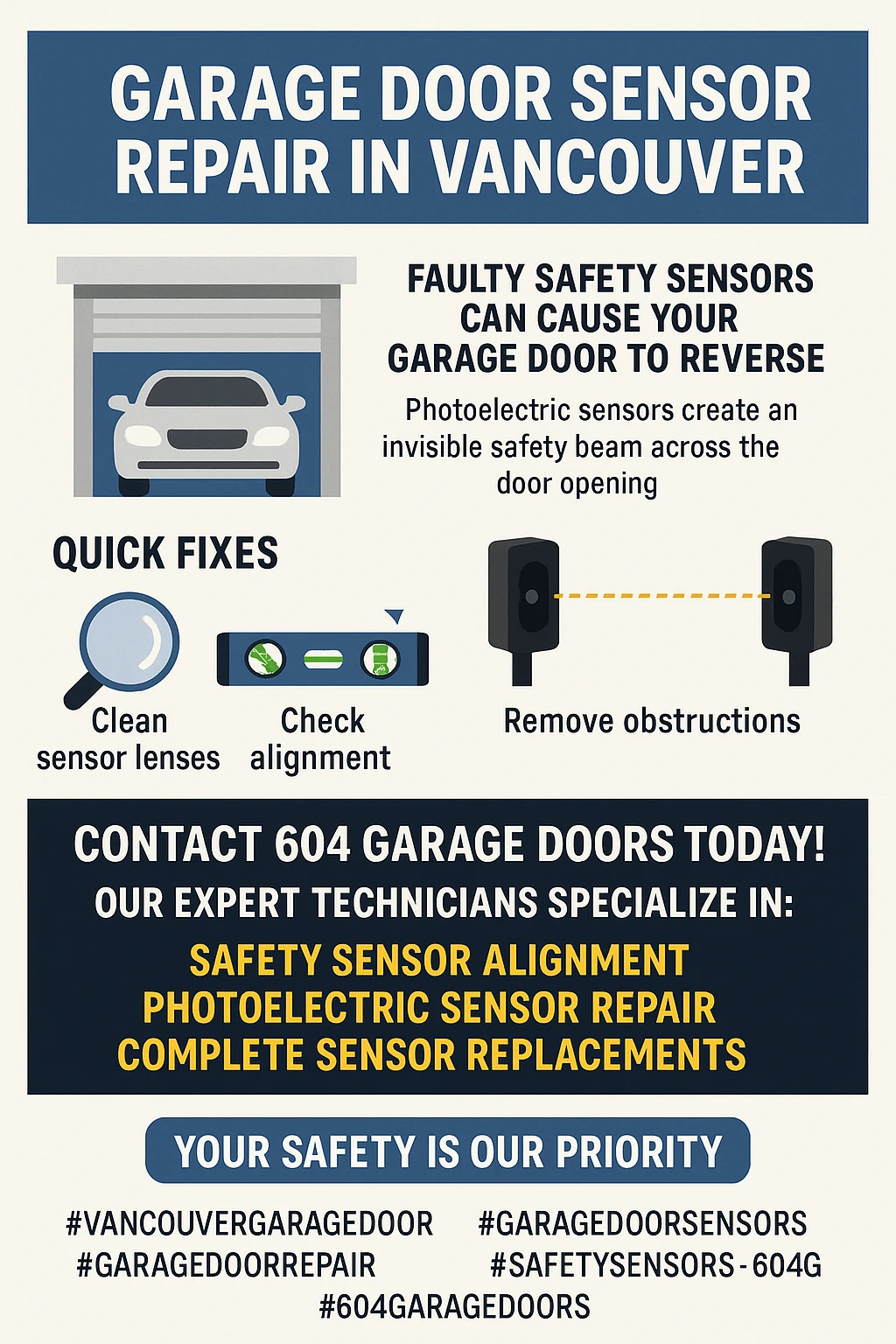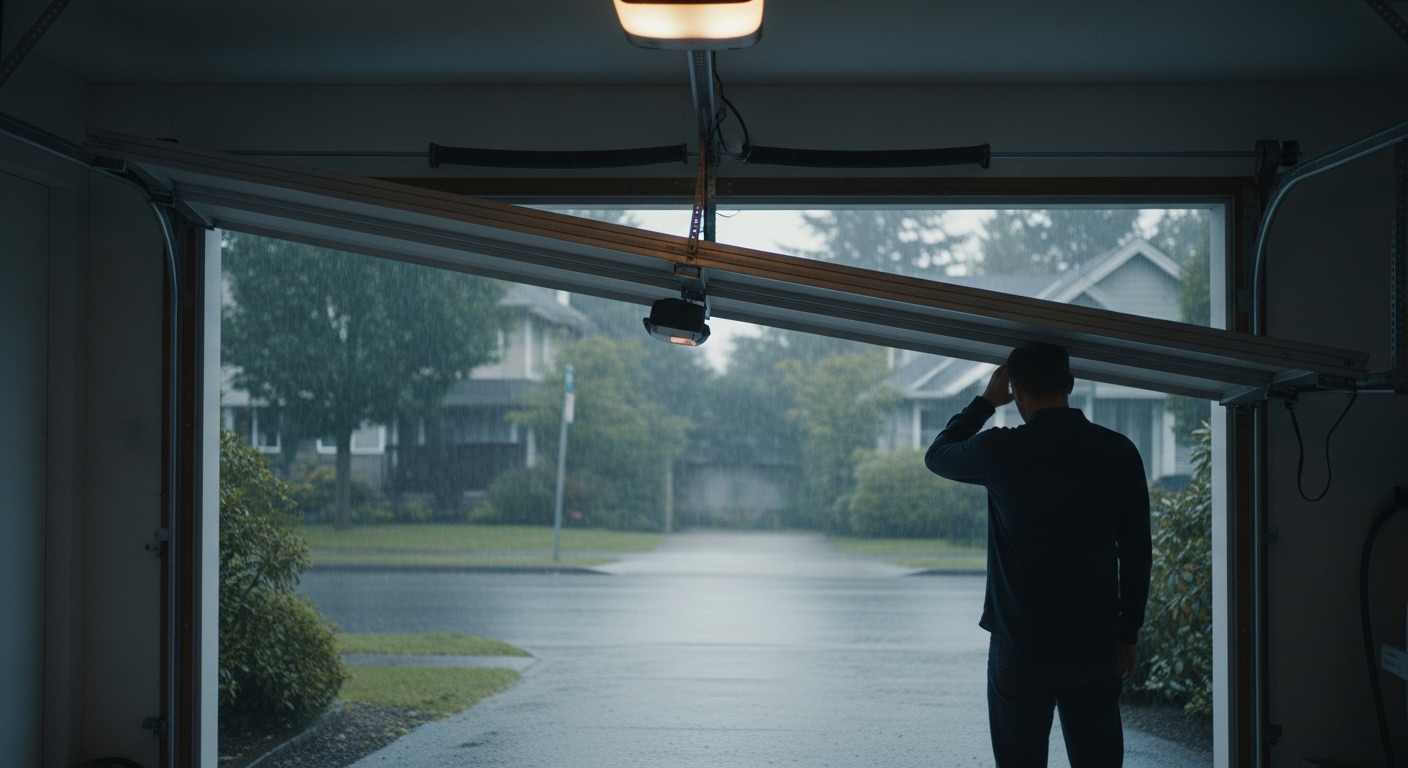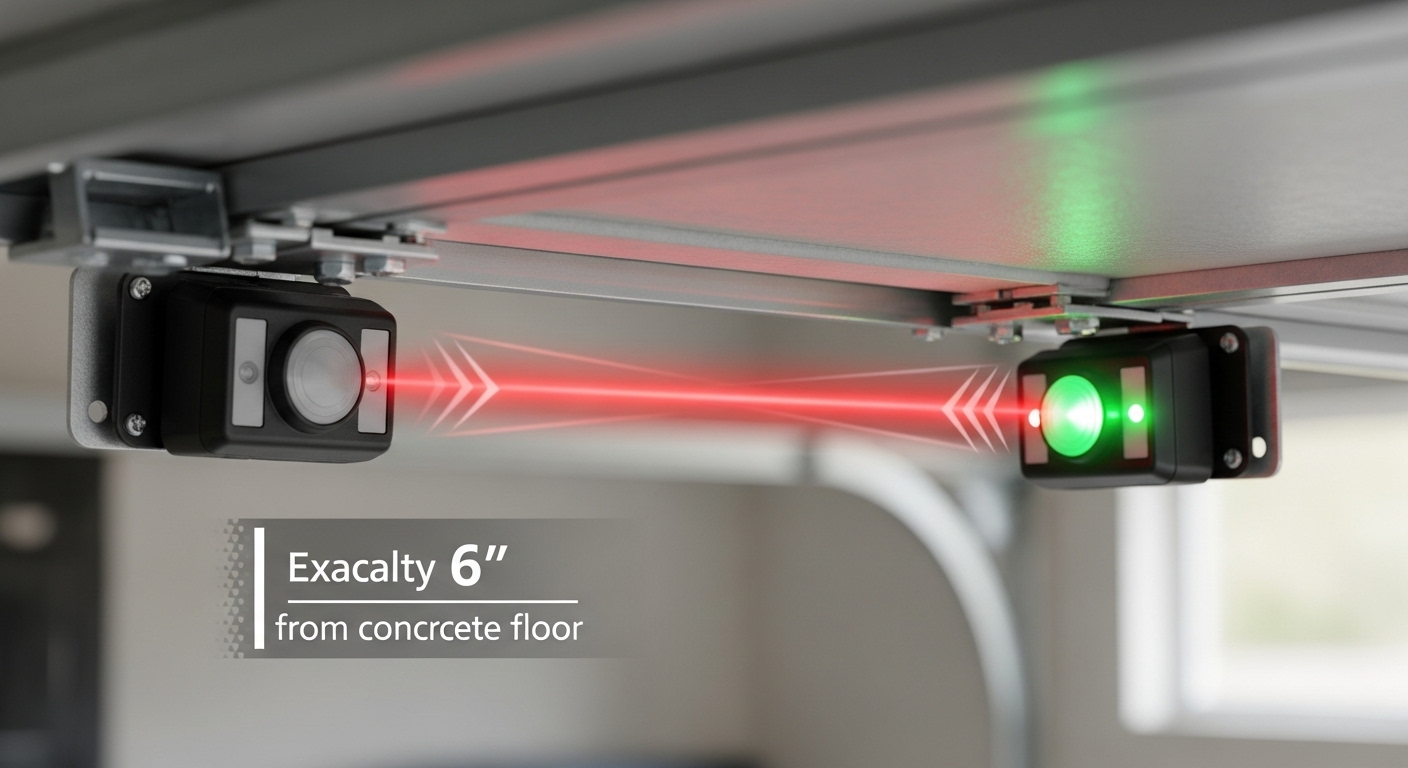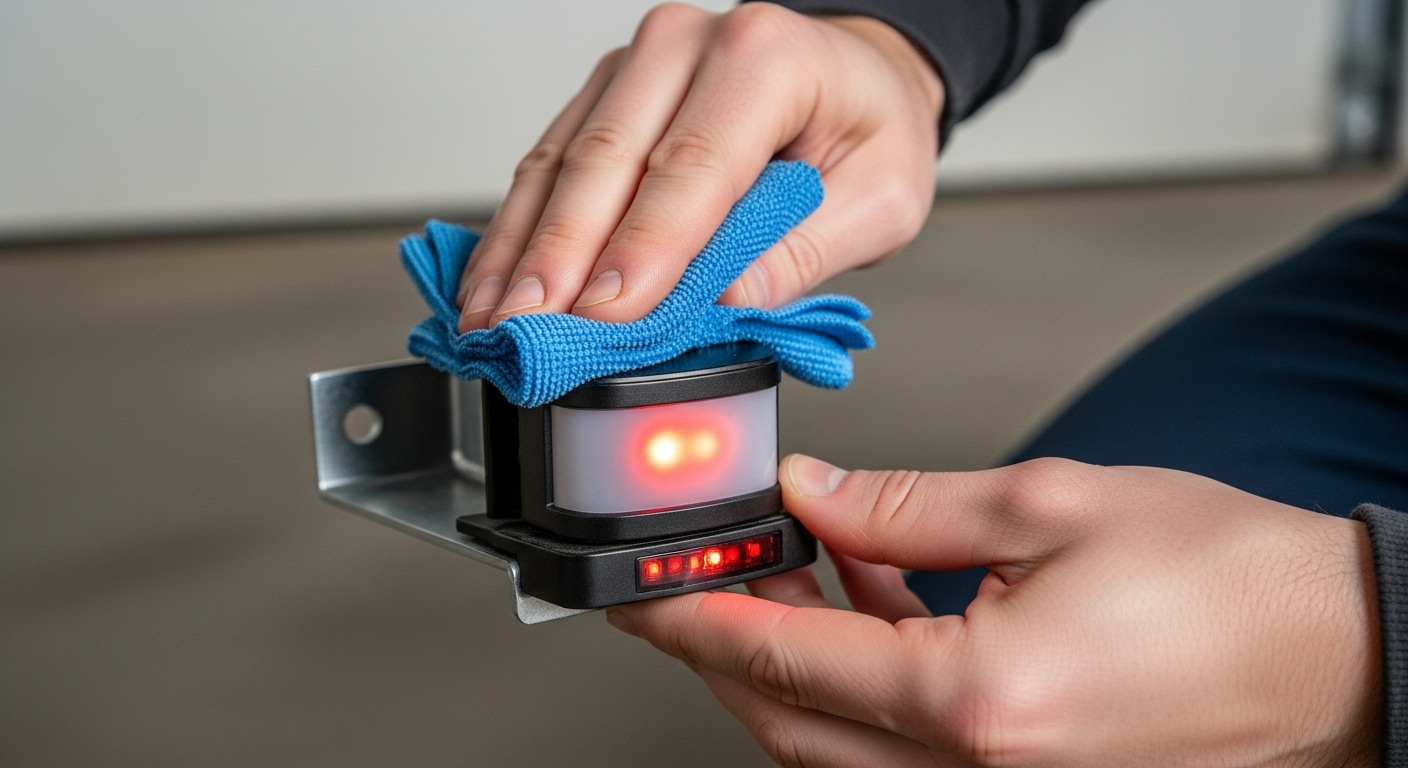Frustrated with a garage door that keeps reversing when you try to close it, especially during Vancouver’s unpredictable weather? You’re dealing with one of the most common yet fixable garage door problems – faulty safety sensors that can turn your simple routine into a daily headache.
Picture this: you’re rushing to work on a typical Vancouver morning, drizzle falling steadily, and your garage door decides to play games. It goes down halfway, then shoots back up like it hit an invisible wall. You try again, same thing. Maybe you end up late, frustrated, and wondering if you need to call an expensive repair service.
Here’s the thing about garage door sensors – they’re actually lifesavers disguised as annoyances. These small devices prevent serious accidents and have been federally required since 1993 for good reason. When they malfunction, your door won’t close properly, but the good news is that most sensor problems are surprisingly simple to fix yourself.
Living in Vancouver means dealing with unique challenges for garage door systems. Our wet climate, temperature swings, and occasional windstorms can knock sensors out of alignment or cause moisture buildup that interferes with their operation. Understanding how these safety devices work and what makes them fail is your first step toward getting back to smooth, reliable garage door operation.
Key Takeaways
- Garage door sensors are federally mandated safety devices that have prevented countless accidents since becoming required on all residential openers in 1993
- Most sensor issues stem from simple problems like misalignment, dirty lenses, or obstructions that homeowners can fix themselves with basic tools
- Professional sensor replacement in Vancouver typically costs between $160-$180 including installation, while basic troubleshooting services run $80-$150
- Regular cleaning and alignment checks can prevent 90% of sensor-related garage door problems, especially important during Vancouver’s wet seasons
- Sensors must be mounted exactly 6 inches off the ground and directly facing each other to meet federal safety standards and function properly

Understanding Vancouver Garage Door Safety Sensors and Federal Requirements

Before diving into troubleshooting, it helps to understand why these sensors exist and how they’re supposed to work. Garage door safety sensors aren’t just a manufacturer’s add-on – they’re federally mandated devices that became required after a tragic day in 1988 when two children died from garage door accidents in Minneapolis-St. Paul. This led to the Consumer Product Safety Improvement Act of 1990, making external entrapment protection devices mandatory on all residential garage door openers manufactured after January 1993.
Your garage door sensors use infrared beam technology to create an invisible safety net across your garage opening. One sensor unit sends an infrared signal while the other receives it, creating a beam that’s constantly checking for obstructions. When something breaks this beam – whether it’s a person, pet, or object – the system immediately signals the garage door opener to stop closing and reverse direction.
The federal law is specific about sensor placement: they must be mounted exactly 6 inches above ground level on each side of the garage door opening. This height ensures they’ll detect children, pets, and most objects while staying low enough to avoid being triggered by normal garage door movement. Vancouver homeowners often ask about relocating sensors higher to avoid damage from snow shovels or storage items, but altering this height violates safety standards and can create dangerous blind spots.
In Vancouver’s climate, sensors face unique challenges that homeowners in drier regions don’t encounter. Our frequent rain, high humidity, and temperature fluctuations can cause condensation buildup on sensor lenses, affecting their accuracy. Additionally, the Pacific Northwest’s wet conditions mean more debris like leaves and moss can accumulate around sensor areas. Understanding these environmental factors helps explain why Vancouver garage doors seem to have sensor issues more frequently than those in drier climates.
Modern sensor systems typically show their status through LED indicator lights. A properly functioning system will display steady green lights on both sensor units, indicating they’re powered, aligned, and communicating correctly. When you see red lights, flickering lights, or no lights at all, that’s your first clue that sensor problems are preventing your door from closing normally.
Common Sensor Problems That Cause Reversing or Won’t Close Issues

Understanding the root causes of sensor malfunctions can save you time and money when troubleshooting garage door problems. Over half of all sensor issues stem from misalignment, which happens more often than most Vancouver homeowners realize. Your sensors can get knocked out of position by something as simple as bumping them with a garbage can, bicycle, or lawn equipment. Even small vibrations from the garage door’s operation can gradually shift sensor positions over weeks or months.
Dirty sensor lenses rank as the second most common culprit behind garage door reversing problems. Vancouver’s environment is particularly challenging for keeping sensors clean – our frequent rain creates muddy conditions, while forests and gardens contribute to pollen and debris buildup. Dust, cobwebs, water spots, and even tiny insects can accumulate on the delicate sensor lenses, blocking or distorting the infrared beam. What looks like a minor smudge to your eye can completely disrupt the sensor’s ability to function properly.
Obstruction detection issues often frustrate homeowners because they can’t see what’s triggering the sensors. Sometimes the “obstruction” isn’t a physical object but rather uneven garage floors, damaged weather sealing, or debris stuck in the door tracks. Vancouver garages are especially prone to leaf and moss accumulation during fall and winter months, creating unexpected obstructions that trigger the safety system.
Sunlight interference presents a unique challenge that varies throughout the day and seasons. Direct sunlight can overpower the infrared signal between sensors, essentially “blinding” them during certain times. This is why some Vancouver residents notice their garage doors work fine in the morning but act up in the afternoon when the sun hits their sensors at just the right angle. South-facing garages are particularly susceptible to this problem.
Environmental factors specific to to Vancouver create additional sensor challenges that homeowners in other regions don’t face. Our high humidity levels can cause condensation buildup inside sensor housings, affecting their electronic components. Temperature fluctuations between warm indoor garage air and cold outdoor air can create fog on sensor lenses. Additionally, moisture can corrode wiring connections, leading to intermittent sensor operation that’s frustrating to diagnose.
Wiring connection problems represent the most complex sensor issues homeowners encounter. Over time, wire nuts can loosen, connections can corrode, or wiring can get damaged by rodents or moisture. These electrical issues can cause sensors to work intermittently – functioning perfectly one day and failing the next. Vancouver’s wet climate accelerates corrosion in outdoor electrical connections, making regular inspection of sensor wiring particularly important for local homeowners.
Step-by-Step Troubleshooting Guide for Vancouver Homeowners

When your garage door starts acting up, a systematic troubleshooting approach can diagnose most sensor problems quickly and safely. The key is working methodically from the simplest solutions to more complex issues, which often saves both time and money on unnecessary service calls.
Start with a visual inspection of your sensor system to identify obvious problems. Look for steady green lights on both sensor units – this indicates proper power and alignment. If you see flickering lights, dim lights, or no lights at all on one or both sensors, you’ve identified alignment or power issues. Check that both sensors are pointing directly at each other and haven’t been bumped or shifted. Vancouver garages often have sensors knocked out of position by snow shovels, storage items, or even strong winds during storms.
Cleaning your sensor lenses should be your next step, and it’s more important in Vancouver’s climate than in drier regions. Use only a soft microfiber cloth to gently wipe each sensor lens. Avoid paper towels or tissues, which can scratch the delicate surfaces, and never use cleaning chemicals or water directly on the sensors. Pay special attention to removing water spots, which are common in our rainy climate and can significantly distort the infrared beam. Clean both the sending and receiving sensors, even if only one appears dirty.
If cleaning doesn’t resolve the issue, check sensor alignment by loosening the wing nuts or mounting brackets that hold each sensor in place. Gently adjust the sensors until both LED indicator lights show steady, bright signals. The infrared beam should pass directly between the sensors without obstruction. This process requires patience – tiny adjustments can make significant differences in sensor performance. Many Vancouver homeowners find that


